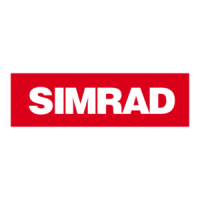%CHOSOUNDERFREQUENCY 50 kHz or 200 kHz can be selected to suit the task.
200 kHz is for general purpose and offers optimum discrimination and a nar-
row transmitter beam with a 15° opening. 50 kHz is for searching in a wider
area, determining bottom conditions and going the deepest. The transmitter has
a wide transmitter beam with a 45° opening.
'AIN Is another way of saying "sensitivity", or possibly "volume". Increasing
the gain setting of the CE32 MKII Echosounder function will allow you to see
smaller and deeper targets. If the gain is set too high, however, you will begin
to see "noise" and unwanted targets.
Generally speaking, you want to set the gain control just below the point that
you begin to see speckles of "noise" on the screen.
0INGTOPINGFILTER Can be set either on or off. With the filter ’off’, then each
received echo will be reflected on the screen. Whereas with the filter ’on’, the
system will compare every two echoes received and only reflect on the screen
what is received from both echoes, which will give a more uncluttered and pre-
cise recording.
0ULSELENGTH The transmitted pulse length can be set to:
50kHz 200kHz
SHORT = less than 5 m deep water. less than 5 m deep water.
MEDIUM = between 5 and 50m between 5 and 50m
deep water. deep water.
LONG = more than 50 m deep water. more than 50 m deep water.
AUTO = will continuously adjust the pulse length to be at an uptimum
level.
F A long pulse will reach deeper but give less resolution.
2ANGE Refers to the distance shown from the top to the bottom of the display
screen.
2ANGESTART Allows the user to set the displayed depth range to begin at some
point below the surface. For example, a 100 meter displayed range can be
’phased’ downwards, so that the screen shows a 100 meter section beginning
at, say, 200 meters and going to 300 meters depth.
F Limitation! With the White line feature activated at the same time as the
!PPENDIX! #%-+))'LOSSARYOFTERMS
108

